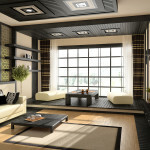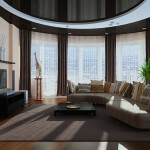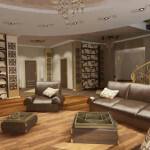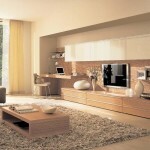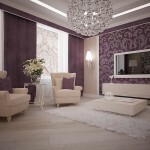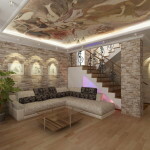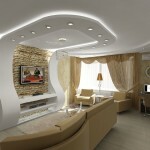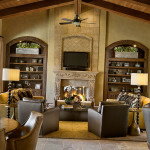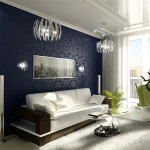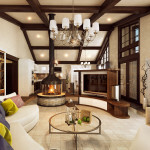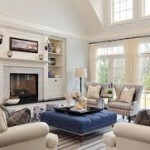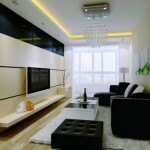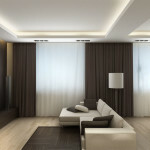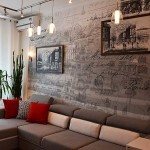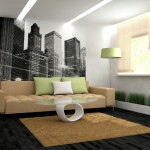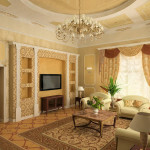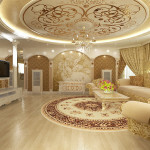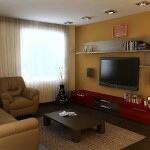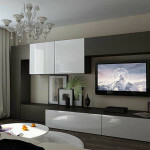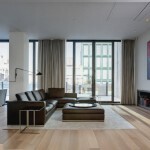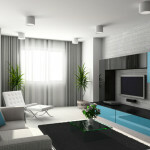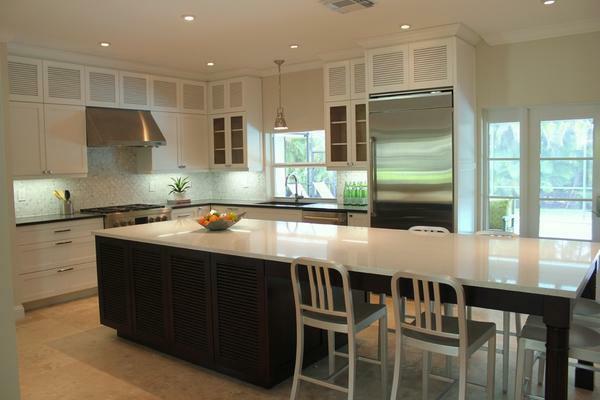Repair hall (33 photos) way to finish the walls, ceiling and floor
Table of contents
-
1 Requirements for the finished result
- 1.1 Types of repairs
-
2 Work associated with the restoration of the walls
- 2.1 Methods of repair of walls and ways of their implementation
- 2.2 Installation of GCR and OSB
- 2.3 Stretch wall
- 3 Methods of finishing the ceiling
- 4 Methods of floor finishes
- 5 Output
- 6 Photo Gallery
How do I repair the hall in the apartment and what materials are used for this purpose? The answer to this question is forced to look for many Koreans involved major repairs in the apartment or a country house.
Interest in this topic is not accidental, as the hall, or as it is called the sitting room, is a place where residents together to spend most of the time. Consequently, it is the premise involves frequent need for regular cleaning and is living in the first place, is in need of cosmetic renovation.
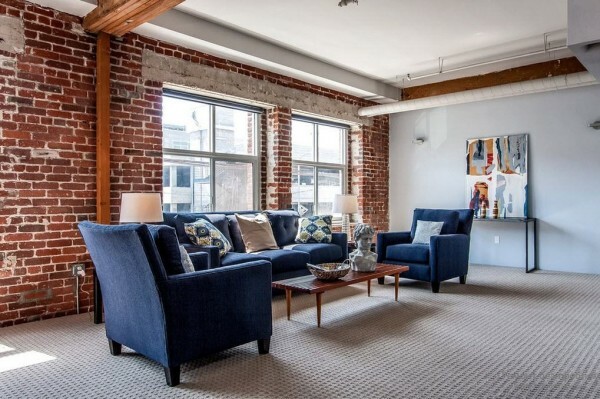
An example of the original design living room
So, what methods of repair are relevant in relation to the living room and what materials can be used at the same time?
Requirements for the finished result
Before you consider relevant options repair room, take a look at the requirements for the finished result.
Among these requirements, it should be noted the following:
- the durability of the finished result, and, as a consequence, the need for the next repair is not earlier than in 5-7 years;
- and aesthetic appeal as a result, a harmonious combination of interior decoration elements with different surroundings;
- compliance with the final cost of the finished result, the budget allotted for the entire project;
- compliance with the time spent in advance of schedule repairs.
Types of repairs
Repair hall in the building according to the degree of difficulty is divided into the following varieties:
- capital - a complex process in which you are remodeling the room, complete replacement of flooring, walls, ceiling, etc .;
- cosmetic - superficial type of repair, designed to eliminate the defects or other external walls, floor and ceiling.
In accordance with the place of performance of repair work are different, aimed at the restoration of the floor, walls, ceiling, window and door openings. These works can be performed individually in case of a limited budget or complex, which is more preferable.
Our school repairs hall will put in order in accordance with the above requirements. For this we consider separately methods for performing repair and types of materials used for their implementation.
Work associated with the restoration of the walls

Here is the room after the repair of the walls, ceiling and floor
In order to choose the best option for repairs, it is necessary to evaluate the condition of the walls, determine the nature of defects and damages, if any, and only then proceed with their elimination.
If the finish of the walls lost its brightness and attractiveness of the color, so it's time to perform a facelift, designed to update the surface, and no more.
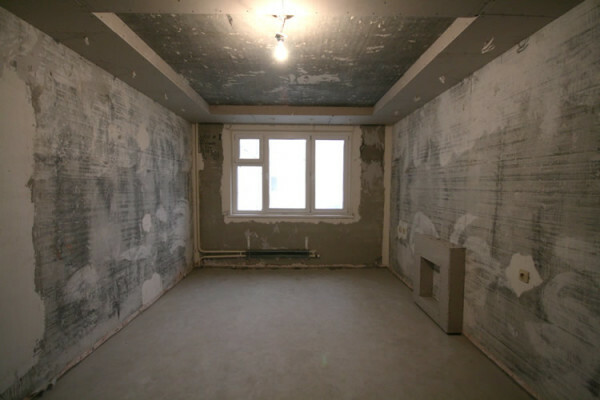
Preparing walls for facelift
More serious overhaul may be required if:
- due to operational reasons plastered on multiple surface cracks appeared;
- on the surface of the walls have mold or dampness stains;
- there was a need in the hidden laying of utilities;
- it was necessary to redevelop the premises, with the erection of the partition wall.
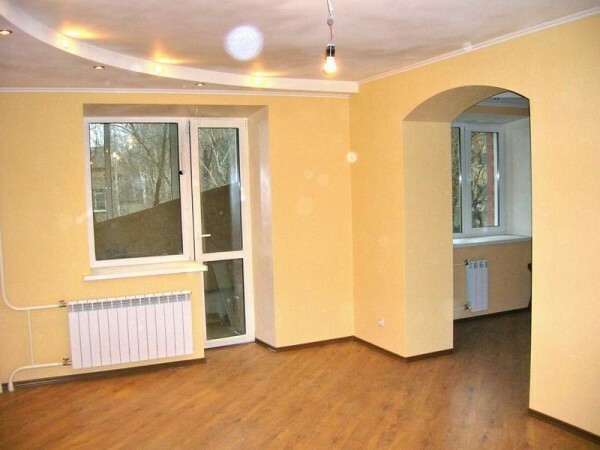
The configuration of the walls, with a modified replanning
Decorating the walls with the overhaul of the following ways:
- plastering;
- Installation of plate decorative materials in the preset crate;
- installation of so-called stretch wall.
Let us consider each of these points.
Methods of repair of walls and ways of their implementation
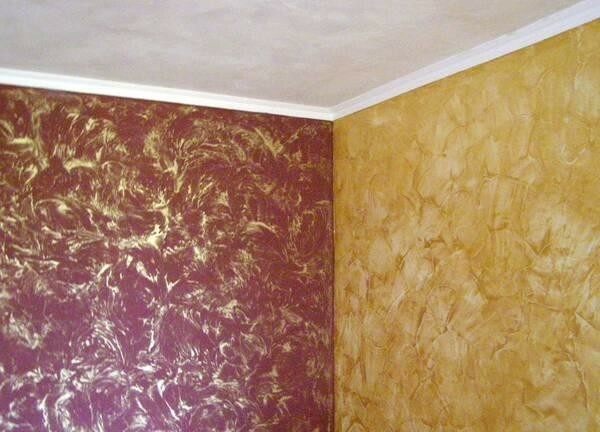
Decorative plaster
Plastering - a finishing process that includes applying to the prepared surface of plaster materials and their subsequent alignment. Selection plastering materials and their method of application depends on the topography of the rough surface of the original from which the wall is formed.

Alignment plaster layer
Standard plastering of the walls consists of the following steps:
- applying a primer to the rough surface;
- printing plaster grid;
- application framework and alignment;
- applying a topcoat alignment;
- polishing the finished result.
Important: The performance of the repaired wall will thus depend on how well dried out every layer of plaster.
If the final layer is laid on the dried basis is bad, the wall may subsequently tread characteristic spots that will not be possible to close the ink layer.
As regards the choice of materials for plastering, the best option is a mixture based on gypsum. Such mixtures are made with varying degrees of granularity filler.
If you want to close up small bumps is not more than 1 cm, it is possible to use a mixture intended for finishing. If it is necessary to align the relief with difference levels of over 1 cm is used for rough leveling the mixture, which differs better adhesion and a more affordable cost.
Installation of GCR and OSB

Aligning the seams on the wall of plasterboard
If you want not only to align the wall, but also change their configuration, board materials are used, which are mounted on pre-manufactured crate.
Through this method you can not only decorate the walls, but also to build a separate partition, when it comes to redevelopment premises.
The advantage of using slab-type materials for the repair of the walls is as follows:
- the possibility to block a shield large space;
- the opportunity to place a finishing material insulation;
- the ability to perform a variety of hidden laying of utilities;
- possibility of obtaining a perfectly flat surface is much faster than with plastering.
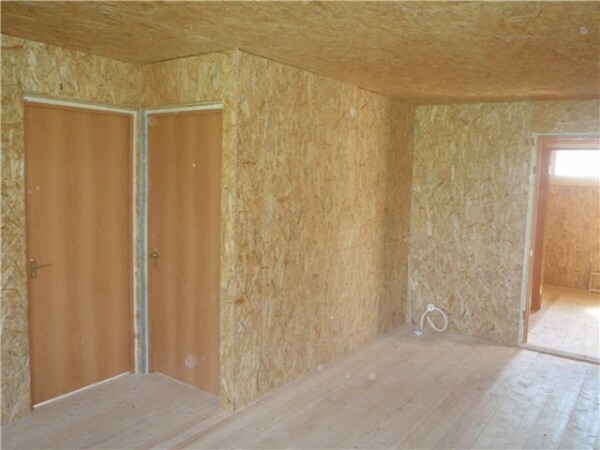
Finish OSB
In deciding on the finishing wall board materials, make sure that the result will be environmentally friendly. For example, the use of plasterboard and oriented strand boards is safe, since these materials do not contain carcinogens.
At the same time the use of particle board in such applications is not recommended, since this type of plate materials in a binder comprising phenol formaldehyde resin.
Important: Finishing board surface chipboard it is only permitted if the plate is completely covered with a laminating film, which will prevent the evaporation of phenol formaldehyde.
If during finishing drywall is used, require subsequent coating and finishing alignment, then trimmed so that the surface to be painted.
Use as fabric SIR does not involve the need for plastering, as these plates themselves look good, and so finished wall will only have to cover the colorless varnish.
Stretch wall

Tension vinyl wall
If the repair is living in the house must be done in a short time, instead of the traditional decoration can apply the so-called stretch wall. This relatively new technique, in which the rough surface is attached to the frame on which the fabric is stretched.
Unlike suspended ceilings, where the stretched cloth is also used, for finishing walls apply dense nonwoven material based on polyvinylchloride. The advantage of using the stretch of walls is a wide choice of colors and textures. For example, you can order both monochrome and multi-color decoration of the walls. Furthermore, the wall surface may be glossy or matt.
Methods of finishing the ceiling
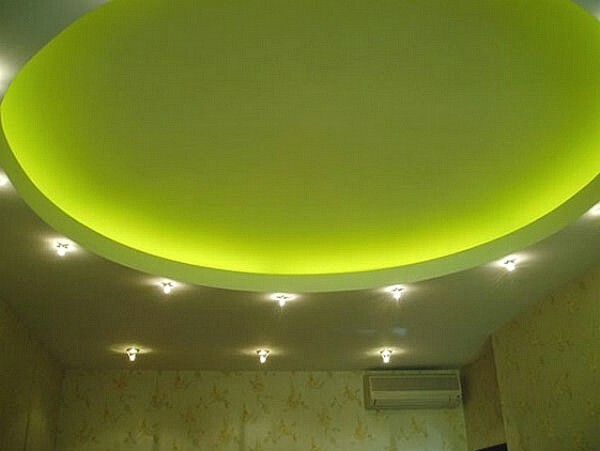
Trey ceilings of plasterboard and vinyl
ceiling finish in the following ways:
- plastering;
- finishing plate materials;
- the use of a stretch ceiling.
If you have to repair a small room, then as finishing techniques can apply any of these methods. If you have to work the room large, it is not recommended for ceilings, as it is possible sagging cloth.

Duplex suspended ceiling with hidden illumination
Suspended ceiling - a technology, according to which the perimeter wall is fixed metal frame. On the frame is tensioned PVC fabric.
Typically web width is no more than 2.5 meters. Therefore, in the decoration of the premises with a few large size paintings are welded together to form a single fabric with the desired area.
Among the distinctive advantages of modern suspended ceilings note the following:
- antistatic surface and as a result of the absence of accumulation of dust;
- resistance to mechanical stress (more than 20 kg per 1 m² without gap);
- resistance to biological factors (no mildew and fungal infections);
- operational simplicity of care, as there is no need for regular cleaning and washing.
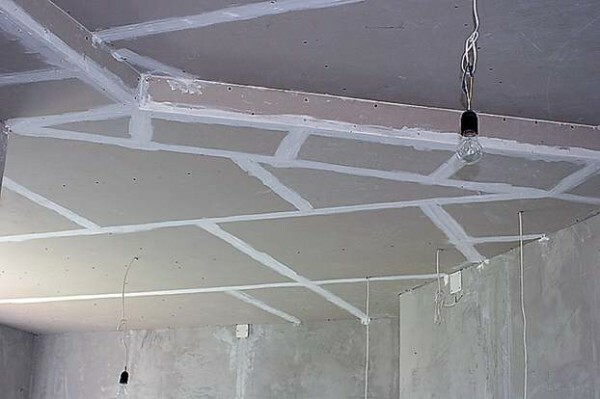
Assembling a two-level structure of plasterboard
Plasterboard manufactured as standard. That is, the first crate mounted from the profile and on it by screws fastened sheets.
Important: Plasterboard presented for sale, different thickness.
For finishing the ceiling it is recommended to get the most delicate finishing material so as not to create excessive mechanical stress on the frame.

The alignment of the ceiling plaster
Plastering Stucco most time-consuming, and therefore its cost is high. As a rule, plaster finish is used for leveling of small embossed on the concrete slab of the ceiling.
Methods of floor finishes
We decided to repair the hall with his hands? So it's time to think about how and with what materials will be carried out floor finish.

Dry screed on Knauf technology
In can be applied as a rough coat:
- plywood sheet, which is laid on the concrete base through the waterproofing layer;
- sheets of drywall, which according to the company Knauf technology of expanded clay are laid on the filling;
- polymer self-leveling screeds;
- cement-sand screed.
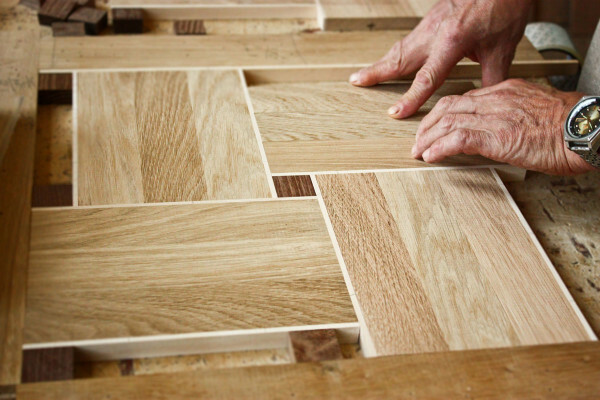
Laying parquet
As the finish floor covering can be used the following materials varieties:
- piece parquet;
- floorboard;
- laminate - an inexpensive artificial substitute for wood flooring;
- linoleum coil coating with different color and texture check;
- carpet and carpet - a carpet available substitutes.
Output
In this article, we renovated the hall in pictures and learn what materials can be used for these purposes. As a result, you can buy everything you need, and to perform the repairs in the apartment or a country house.
Still have questions that need clarification or want to share your thoughts on the read? To do this, you can leave your comments after the article.
Photo Gallery
